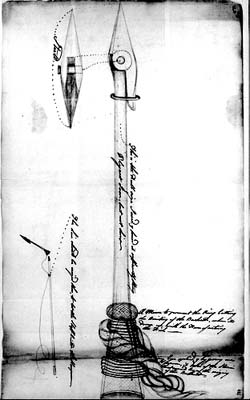 Whalecraft
Whaling
Whalesite
Whalecraft
Whaling
Whalesite


The concept of a toggle head harpoon is quite old. The basic description of a toggle head iron is one where the moveable head is held streamlined to the harpoon shaft for darting, then pivots, or toggles, around the center of the head to a right angle to the shaft after penetration when force is applied to the line, thereby preventing withdrawal.
Ancient Eskimo harpoons were a form of toggle harpoon. They were made of bone or ivory, usually with a stone or metal point, and pivoted around a line through a hole in the center of the head. A flaring rear barb helped to ensure catching in the blubber or flesh to initiate the toggle action. For darting, the head was held streamlined to the shaft by means of the separable shaft fitting into a receptacle hole in the rear of the head. These Eskimo harpoon heads were smaller than later iron toggle harpoons because they were attached to skin floats, and did not have to withstand the force of being attached to a fully loaded whaleboat being pulled through the water by the whale.
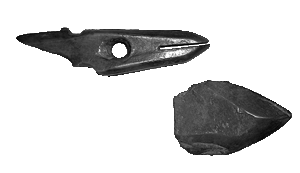

The grommet iron was the first form of iron toggle head whaling harpoon. The head of the harpoon was held streamlined to the harpoon shaft by means of a grommet around the head and shaft. This grommet could be line tied around it, or leather, or most often a metal ring. When the iron was darted the grommet was pushed back off the head by the force of the blubber as it entered. With the grommet pushed back, the head was free to toggle. Such grommet irons were in use for a long time, in later years used more for porpoise and blackfish, or other large fish, such as sun fish or basking sharks. The size of the pivot pin will indicate intended use of the iron. For use on whales, the pin should be 3/8" diameter, and flush with the sides of the head. The pin was formed like a rivet, flared out at the ends to retain it in the head. The diameter of this visible flare was approximately 1/2" for a 3/8" diameter pivot pin. Smaller pins indicate use on smaller fish, and not intended to pull a boat through the water.
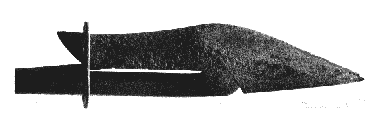
Grommet toggle iron with iron ring grommet The earliest record of a grommet harpoon I have found is a sketch made by Francis Thompson circa 1772. This design was made for Joseph Banks in preparation for a second voyage to the Pacific South Seas for the purpose of scientific discovery. James Cook was given command of this second Pacific expedition (1772-1775) to search for a southern continent. He sailed from England in July 1772 in HMS Resolution accompanied by HMS Adventure. The expedition circumnavigated the world in high southern latitudes. Joseph Banks, invited by Lord Sandwich to join the expedition, withdrew from the voyage finding the Resolution unsuitable to accommodate his intended party. Since this was not a whaling voyage, the harpoon may not have been intended for whales.
'Mr Thompson's Harpoon', c. 1772, pencil drawing possibly by Francis Thompson, the engineer. (ML Ref: Banks Papers, Series 6: 132)
Mitchell Library, State Library of New South Wales
Grommet irons were made through the nineteenth century. The following illustrations show some variation to these irons. At least one version was made with a metal leaf spring that helped to initiate the toggling action. Most grommet irons exhibit a small pivot pin, indicating their intended use was porpoise, blackfish, sharks, etc., not whales.
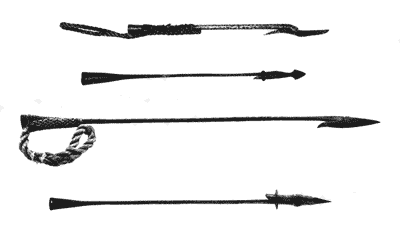
The drawback to the grommet irons was the fact that the grommets were pushed off during penetration, when the blubber contacted the grommet. This allowed the head to toggle open prematurely, and when that happened there could be no further penetration; the opened head across the shaft prevented it. Therefore the catch would be lost.
In 1848 Lewis Temple, an African American blacksmith in New Bedford, made an improved toggle iron, and is generally given credit for the invention of the toggle iron. He apparently knew about the Eskimo harpoons, the grommet irons and the action of the single flue iron bending to cause the head to rotate across the axis of the shank to prevent withdrawal. One very early version of the Temple iron was an improved version of the grommet iron that prevented the premature opening of the toggle head during penetration. This harpoon was made with a line tied around the toggle head to keep it streamlined to the shaft for darting. The head was made with a front barb that cut the opening in the blubber and protected the grommet from being pushed off prematurely. The flaring rear barb, which caught in the blubber or flesh to toggle the head open, was made with a sharpened top edge that would cut the grommet after complete penetration, due to the toggling forces, allowing the head to pivot open. The grommet was positioned between the barbs where it was protected.
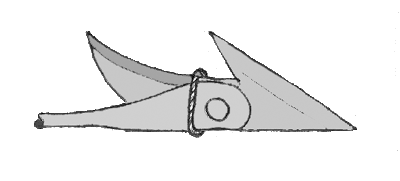
Concept of Temple's improved grommet iron, with rope grommet cut by rear barb. This lead directly to the Temple Toggle Iron which became a whaling industry standard. Very soon Temple replaced the grommet by a small wood shear pin placed through holes drilled through the head and shaft. This wood pin held the head streamlined to the shaft for darting, and would not allow early toggling. After complete penetration when force of the running whale was applied to the whale line, the rear barb caught in the flesh or blubber and forced the toggle head open. The wood pin holding the head in
place sheared allowing the head to toggle open. This final design is the one for which Lewis Temple is famous. It was known as Temple's gig, or more commonly as the Temple iron. It retained the feature of the front barb and rear barb. In fact, later improvements retained the double barb configuration and the wood shear pin. This became the
industry standard for whaling harpoons.
Temple iron detail - Authors collection.
Temple made his iron by forging a separate U-shaped piece to the end of the shaft to accept a cast iron toggle head. The heads were cast in a local iron foundry and sold to the blacksmiths; the blacksmith did not forge toggle heads, but finished them. The head fit snugly between the cheeks of the U-shaped section, and a hole for the pivot pin was drilled through them. After the pivot pin was in place, and flared at the ends to secure it, the hole for the wood shear pin was drilled through with the head in the darting position.
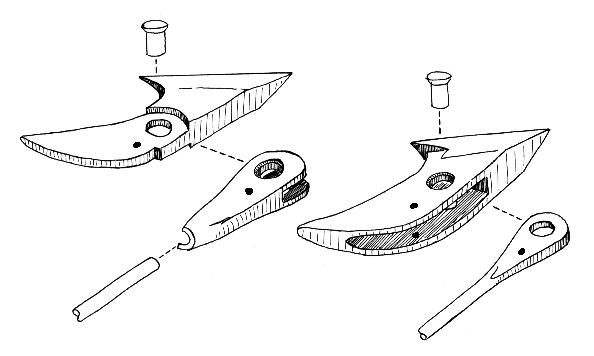
Construction differences between Temple toggle (left) and improved toggle (right). The Temple toggle iron was difficult to make due to the U-shaped section. An improvement was made in which this extra piece was eliminated. The end of the shaft was simply flattened and inserted into a recess cast in the cast iron toggle head. An
added benefit was an increased flat area of the toggle head presented to the blubber after the head toggled, giving more holding power. No one is credited with this improved toggle iron, but it became the industry standard beginning in the 1850's.
There were some differences in the shape of the toggle head, depending on which foundry cast them. There was no performance difference attributed to one over another.
Toggle head styles; acute (top) and obtuse (bottom). Author's collection.
Word of the success of toggle irons spread quickly. The following was printed in The Whalemen's Shipping List, and Merchants Transcript on May 31, 1853, and is typical of the reports which led to the popularity of toggle head harpoons:
The ship Ohio, Capt James A. Norton, which arrived at this port on Saturday, took all her oil the last season in the Arctic seas. Twenty-two bow-head whales were struck, and twenty-one of them cut in, making 2350 bbls. of oil. In the capture of these twenty-one whales but eight harpoons were used, and not one lost. The only loss of craft or tow-lines sustained was upon the whale which was struck and not captured, and which parted the short warp and went away with one harpoon and two fathoms of tow-line. The harpoons used were toggle-irons.
It must be noted that the use of only eight harpoons was exceptional and whaleships continued to carry 150 or more harpoons for a four-year voyage.
The improved toggle iron was never superseded by any other hand-darted harpoon. It was in use in the American whale fishery up to the final voyages in the mid-1920's. There were, however several attempts to improve upon the design in one way or another. The most notable attempts are detailed below.
Babcock Iron 
One of the earliest variations to the toggle head was invented, but never patented, by Capt. Elisha Babcock in 1860. Babcock was a whaling master on Ship Lydia of Fairhaven in 1860 and Bark Adeline Gibbs of New Bedford in 1866. This design may have been tried one of those voyages, but there is no record of it. The Babcock toggle iron was made in the fashion of the Temple iron, with the malleable cast iron head positioned between cheeks of a U-shaped section forged to the forward end of the shaft. A wood shear pin secured the head in the streamlined darting position.

The head configuration was different in that it combined the toggle head profile with the old two-flue head. The top ridge of the toggle barb was sharpened as were the two-flue edges. This two flue toggle design resulted in more surface area for holding power, but the area was mostly forward of the pivot pin, under the two flue portion of the head configuration. The result was that when resisting force was applied to the head after it toggled open, there was more force on the larger area forward of the pivot pin, and this tended to cause the head to pivot back into its streamlined position. When this occurred, the size of the head was the same size as the entry wound and the iron could draw out. The larger head (two flue plus toggle head) profile was also large and would have made penetration somewhat more difficult. The Babcock iron never became popular.
Balance Toggle Iron 
The balance toggle design is attributed to James Durfee, a New Bedford blacksmith, and the iron is sometimes called the Durfee Balance Toggle, although there is no documentation to substantiate this. The design was never patented.
To maximize holding power a large flat surface was needed to resist pulling out after the toggle head opened. In addition, the surface area to resist pull-out had to be equal on both sides of the pivot pin, i.e., the forward part and the after part. If the areas were unequal, the force of the blubber on the toggle head would act similarly as the force
of the wind on a weathervane; the larger area would get more force pushing that side away. (This was the problem with the Babcock iron above). To answer these requirements, the so-called balance toggle head was developed. A wood shear pin held the head in the streamlined darting position, as it did in most toggle head designs.
The balance toggle never became popular, probably because the head was too large and made penetration difficult. To have a large surface area for resisting pull out, a large head was necessary.
Diamond Point Toggle 
A toggle iron that focussed on ease of penetration was the diamond point toggle iron. This design was never patented and the originator is unknown. It was introduced around 1857. Although rare, there are several known examples. The point of the toggle head was sharp on two edges like a spear point,
supposedly to make penetrating tough blubber easier. A wood shear pin held the head in the streamlined darting position. The problem was that when the head toggled open a sharp edge was brought to bear on the blubber or flesh rather than a broad flat surface. This would have allowed the iron to cut its way back out when forces from a running whale were applied. In "The Log of the Bark Emily ... 1857 - 1860" by John R. Spears, in Harper's Monthly Magazine, 1903, the use of the diamond point toggle on November 13, 1857 is described. After whales were struck, two irons pulled out because
...the "new-fangled" diamond point cut its way through the flesh as soon as the strain of towing the boat was brought on by the mad rush that the whales made for liberty.
The diamond point toggle never became popular.
Doyle Iron 
One toggle design seemed to answer most requirements, but failed in another. The Doyle iron, patented by George Doyle of Provincetown, MA (U.S. Patent #21,949, Nov. 2, 1858) was designed to present the broad flat side of the toggle head to the blubber or flesh to oppose withdrawal rather than the narrow edge of the toggle head. This iron is also known as the Provincetown Toggle. It had a low profile to facilitate penetration, and had a point sharp on two edges to also facilitate penetration. The configuration resembled two standard toggle heads placed bottom edge to bottom edge. Further, the head could toggle open in either direction.
There was one problem; Doyle did not use a wood shear pin to hold the head in the streamlined darting position. His second patented feature was a small lip on the shank that engaged a corresponding recess in the toggle head to keep the head in the streamlined darting position. The hole in the shaft to receive the pivot pin was elongated, so the head could shift forward with respect to the pivot pin. The idea was that during darting the head would be positioned back with the lip engaging the slot in the head. After darting, when tension was applied to the whaleline, the forces would cause the shaft to pull back slightly with respect to the head, thereby disengaging the lip from the retaining slot and allowing the head to toggle open. I have held this harpoon in the darting position, with the head angled downward slightly, and gravity caused the head to slide forward disengaging the lip from the recess. The head then immediately toggled. If darted, the broad flat side of the head would hit the side of the whale and there would be no penetration at all.
While all considerations for ease of penetration, broad surface area to resist withdrawal and a balance of resisting areas were considered, the Doyle iron never became successful because the head was not held securely in the darting position.
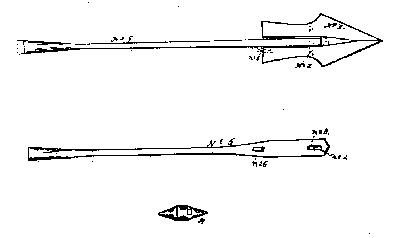
Patent drawing for the Doyle Iron.
British Toggle Iron with Stop Wither 
British toggle iron with stop wither. Length is 33-3/4". Maker's mark J.L.P.75 on one side of the head, and whaleship's identification opposite side, VICTOR. Examples of British toggle irons are seen with the stop wither feature (described in detail under two-flued irons). The design is illustrated by Capt. William Adams of Dundee, Scotland in "The Fisheries and Fishery Industries..." 1887, by George Brown Goode, plate 195. Goode states that this is a "Hand-harpoon now most in use on the Scotch whaling steamers." The example shown above is constructed similar to a Temple iron; the head pivots in a clevis forged to the end of the shaft. The illustration by Capt. Adams also shows this construction. It must be noted that Capt. Adams also illustrates a British toggle iron very much like the improved toggle iron, with no stop wither. Goode's description of this illustration is, "Hand-harpoon in general use about 1857." All the illustrations in this plate of the book are for British harpoons.
The iron shown above is a very large iron; the head is 10-1/4" long and 13/16" thick. The shaft is 7/16" diameter. Such a heavy iron would have been difficult to dart. It may have been used for raising whales that sank after they were killed. This type of harpoon, called a whale raiser, was common for the humpack whale fishery where dead whales sank.
Back to top of this page

